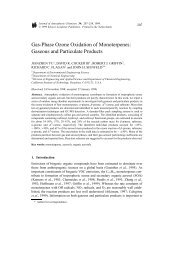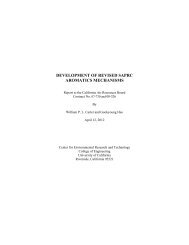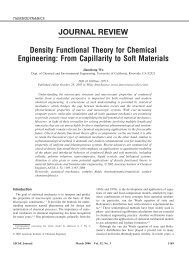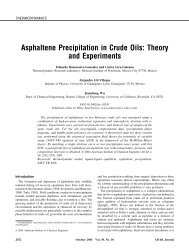View extended abstract in PDF format
View extended abstract in PDF format
View extended abstract in PDF format
Create successful ePaper yourself
Turn your PDF publications into a flip-book with our unique Google optimized e-Paper software.
cont<strong>in</strong>uously measured. NO and NO x are cont<strong>in</strong>uously quantified us<strong>in</strong>g a chemilum<strong>in</strong>escent<br />
monitor with a converter that reduces NO x to NO. Because the NO x from this <strong>in</strong>strument is<br />
subject to <strong>in</strong>terferences from PAN and other organic nitrates, it is a good measure of NO+NO 2<br />
only dur<strong>in</strong>g the early stages of photochemical conversion. Ozone is cont<strong>in</strong>uously monitored<br />
dur<strong>in</strong>g the experiment with a chemilum<strong>in</strong>escent monitor. Measurements of organic precursors<br />
and reaction products were identified by us<strong>in</strong>g GC with detection by flame ionization (FID),<br />
electron capture (ECD), or mass spectrometry (MS), with samples taken at 1 to 2 hour <strong>in</strong>tervals,<br />
depend<strong>in</strong>g on the experiment. Peroxyacetyl nitrate (PAN) and other peroxyacyl nitrates were<br />
measured by GC/ECD at 1-hour <strong>in</strong>tervals. Measurements of carbonyl compounds were obta<strong>in</strong>ed<br />
by bubbl<strong>in</strong>g sample air through a solution of 2,4-d<strong>in</strong>itrophenylhydraz<strong>in</strong>e (DNPH) <strong>in</strong> acidified<br />
acetonitrile, produc<strong>in</strong>g carbonyl hydrazones which were separated and quantified by high<br />
performance liquid chromatography (HPLC). Concentrations of nitric acid were obta<strong>in</strong>ed by<br />
sampl<strong>in</strong>g with nylon filters followed by extraction <strong>in</strong> 10 -5 perchloric acid solution and analysis<br />
by ion chromatography. Other <strong>in</strong>strumentation is currently be<strong>in</strong>g evaluated, and alternative<br />
analytical techniques that are be<strong>in</strong>g developed, <strong>in</strong>clude the measurement of organic nitrates by<br />
GC/ECD, determ<strong>in</strong>ation of multifunctional carbonyl compounds with derivatization by<br />
pentafluorobenzylhydroxyl am<strong>in</strong>e (PFBHA) followed by GC/MS analysis, and determ<strong>in</strong>ation of<br />
hydroxylated compounds, <strong>in</strong>clud<strong>in</strong>g organic acids, by derivatization with BSTFA followed by<br />
GC/MS analysis. Exploratory work is be<strong>in</strong>g undertaken to determ<strong>in</strong>e whether new pattern<br />
recognition techniques utiliz<strong>in</strong>g UV absorption spectrometry can be used to measure NO 2 and<br />
HNO 2 directly.<br />
The chamber-dependant reactions are characterized through the use of a limited set of<br />
characterization experiments consist<strong>in</strong>g of s<strong>in</strong>gle component studies of clean air, clean air/NO X ,<br />
CO/NO X , formaldehyde/NOx, and ethylene/NOx experiments. Experiments are performed<br />
under dry conditions and at relative humidities between 50-60%.<br />
Earlier experiments have been performed to study ozone <strong>format</strong>ion potential from a series of<br />
reformulated gasol<strong>in</strong>e and alternative fuel exhaust from new technology vehicles. These<br />
experiments have used authentic exhaust generated from several different vehicles with a<br />
dynamometer and have focused on ozone <strong>format</strong>ion potential as a function of fuel type<br />
(Kle<strong>in</strong>dienst et al., 1994). A set of experimentally-based reactivity parameters were developed<br />
for each fuel. Vehicles run us<strong>in</strong>g reformulated gas (RFG) and ethanol (E85) were found to<br />
produce roughly equal amounts of peak ozone for similar reaction conditions, almost twice as<br />
much as methanol-fueled (M85) vehicles, and over 4 times as much as vehicles run us<strong>in</strong>g<br />
compressed natural gas (CNG). (Measurements were made for standard VOC/NO X ratios of 5.5)<br />
Another result of this work has been the creation of auto exhaust surrogates that were prepared as<br />
tank mixtures us<strong>in</strong>g whole fuel with a dozen additional components represent<strong>in</strong>g the major<br />
combustion-derived components. These surrogates have been shown to reliably reproduce ozone<br />
<strong>format</strong>ion and other photochemical constituents and reactivity parameters compared to direct<br />
automobile exhaust.<br />
Studies of branched and straight cha<strong>in</strong> C 5 -C 8 alkane reactions have been performed <strong>in</strong> the<br />
chamber. Although these compounds are not extremely fast react<strong>in</strong>g, they are emitted <strong>in</strong>to the<br />
atmosphere <strong>in</strong> large quantities from automobile exhaust. For these studies we have comb<strong>in</strong>ed<br />
dynamic and static chamber simulations to better identify and quantify multifunctional
















